Foot fungus is a skin disease that manifests itself by active reproduction in the epidermis of certain types of fungi. Today, both parents with weakened immune systems and children are vulnerable to the disease. The signs of fungus on the feet depend on the type of pathogen of the infectious process and the number of feet and nail plates affected, and at different stages have certain differences, which indicate the development of infection. You should know how to recognize the fungus on your feet, which will allow you to start treatment on time and stop further development.
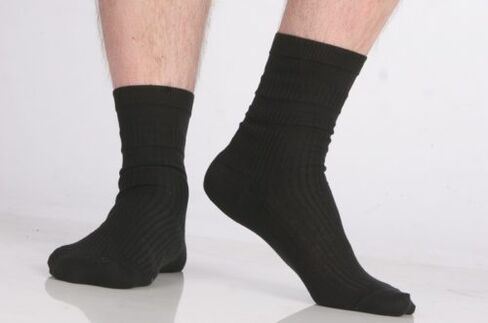
Symptoms of the disease
The main place for the development of fungus on the feet is most often the area between the toes. This pathology is accompanied by the appearance of symptoms such as burning, severe itching and redness of the epidermis. In addition, one can notice the skin cracking and flaking, as well as the formation of blisters on the feet and increased dryness of the dermis.
The same symptoms of fungus on the feet can occur on the sole, and are accompanied by excessive keratinization of the skin. The peculiarity of such a disease lies in the fact that during its course, the formation of an incurable fungus on the foot is possible, and the wound itself is in a state of superinfection.
How to recognize the fungus on the feet, and what symptoms can signal the beginning of disease progression? The first signs of the disease are the appearance of small scales, that is, various types of exfoliation, from small pityriasis to large lamellar. There are many different types of fungi that trigger the development of the disease, but they are all characterized by the same signs:
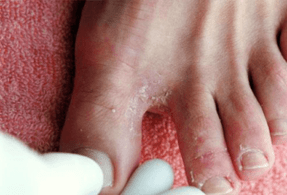
- In the early stages of its development, the pathology persists without the appearance of obvious symptoms. First of all, the interdigital folds are affected and most often between the third and fourth fingers.
- As the fungal disease progresses, the side of the foot is affected, gradually spreading to the ankle.
- With a fungal infection on the feet, the skin significantly thickens, cracks and begins to glow.
- The skin becomes too dry and begins to itch. In addition, the epidermis becomes very red, and the affected area becomes inflamed.
- The patient began to complain of pain and burning in the legs.
- With the transition of the disease to a neglected form, blisters begin to appear on the skin. When opened, the affected skin area becomes very wet and soft.
There are several forms of foot fungus, and each of them is accompanied by the development of certain symptoms.
Pathological forms
Experts identify the following types of fungi that can affect the skin on the feet:
- interdigital;
- hyperkeratotic (moccasin);
- dyshidrotic.
The most common form of interdigital fungus on the feet is interdigital, which is characterized by the appearance of certain signs:
- often, the area of the fourth and fifth toes becomes the site of localization of this fungal form.
- as the disease progresses, the skin acquires a distinctive scaly appearance and may crack severely;
- between 3, 4 and 5 cracks or weeping funnels are formed, which are surrounded by white or green dry skin scales.
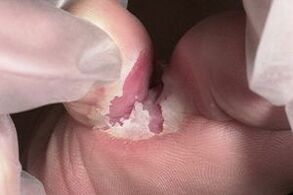
Interdigital fungal skin lesions can be either dry or wet. If wet interdigital fungus is detected, the skin appears swollen. With dry wounds of the epidermis, its exfoliation and shedding are observed.
The first sign of moccasin -like foot fungus is pain, a manifestation observed in the feet. As the pathology progresses, a gradual thickening of the skin on the soles of the feet is observed, which leads to the formation of cracks.
This form of fungal disease on the feet is considered the most difficult and neglected, but it is easily recognizable. Fungal diseases can manifest themselves in the defeat of the nail plate, in which case they acquire a characteristic thickening, are prone to collapse, and may fall off altogether.
The vesicular form of the fungus is characterized by the formation of blisters, in which there is a clear fluid. Gradually, the blisters mature, becoming cloudy and open, resulting in the formation of erosions of various sizes. The main localization of the foam becomes the area closer to the toes on the soles of the feet, but there is a possibility they rash all over the moccasins.
The vesicular form of fungal disease is considered relatively rare, but easier to treat. This is due to the fact that the vesicle becomes the site of localization of the pathogen, that is, it does not penetrate the deeper layers of the skin. When a viral or fungal infection attaches to vesicular fungal disease, serious skin lesions are observed, and treatment becomes difficult.
Experts distinguish the form of the fungus that is extinguished on the feet, in which all symptoms are blurred. Diagnosing such pathology is quite problematic, as the affected skin looks like a messy foot. In patients with such foot fungus, the symptoms are yellowing of the nails and peeling of the feet, but it is so mild that the patient does not pay attention to them.
The extinguished form of the fungus grows in waves, that is, in summer it becomes worse, and in winter it almost disappears completely. With any weakness of the immune system, a sharp exacerbation of the disease is observed, which poses difficulties in the treatment of foot fungus.
How to recognize onychomycosis?
The signs of nail fungus can vary significantly at different stages, signaling the development of an infection. How does toenail fungus start, and what are the signs I should look out for?
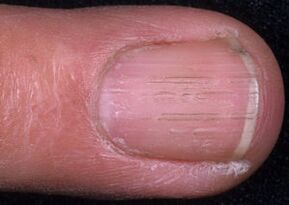
- In the first stage, no characteristic symptoms of the lesion and almost insignificant streaks and spots appear on the nail. If you ignore the early signs of the disease and start the fungus, then the accumulation of pus in the periungual plate area is possible. The result of such pathological processes is gangrene or amputation of the lower extremities.
- With the second stage of fungal disease, the natural luster on the nails disappears. Gradually, the nails change color and white and brown stripes form on it. Deformation of the top of the nail and its sides is possible. Further stages of bacterial nail damage are characterized by increased fragility, delamination and inflammation of the cuticle. The pathology continues its progression and spreads to other nails and feet.
- In the third stage of onychomycosis, the nails become yellow or dirty brown. In addition, it becomes too loose, thickens and lags behind the nail bed. Often, when wearing shoes, severe pain begins, and the itching on the skin becomes unbearable.
There are several types of fungal infections on toenails, each of which causes the appearance of specific symptoms.
- Hypertrophic onychomycosis is accompanied by thickening of the nail and its staining in yellow. The nail is well crushed and a thickened epidermis is visible underneath.
- Atrophic onychomycosis causes thinning of the nail and its destruction, and keratin skin is visible beneath it.
- Onychomycosis, when affected by a fungal fungus, often develops not as an independent disease, but against a background of other pathologies.
Nails can be yellow, brown, green or black. Often complications develop in the form of inflammation of the periungual bed with the discharge of pus.
Pathology prevention
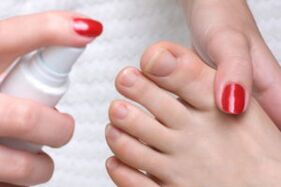
With the normal functioning of the immune system, nail fungus is unlikely to begin its development after infection, as the body is able to cope with it on its own. If the fungal infection still affects the feet and nails, then it is necessary to undergo effective treatment. The sooner the fight against such pathology begins, the higher the patient’s chances for full recovery.
The fight against foot fungus is considered a rather laborious process, so it is easier to prevent the development of the disease. To do this, the following precautions must be followed:
- keep feet dry;
- do not wear other people's shoes;
- choose socks to be made of cotton;
- Don't run barefoot on the beach.
When the first signs of fungus on the feet appear, you should contact a specialist. It is important to identify the pathology early in its development and prevent further development, which will help avoid many complications. To understand how to determine the fungus on the feet, you need to consult a dermatologist.

























